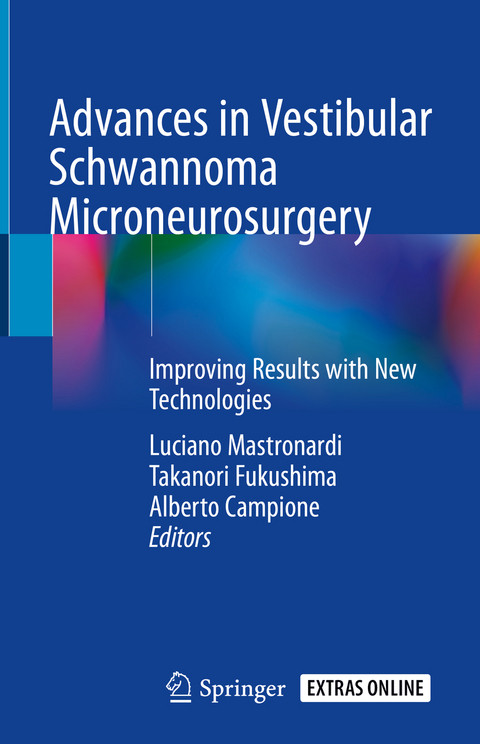
Advances in Vestibular Schwannoma Microneurosurgery
Springer International Publishing (Verlag)
978-3-030-03166-4 (ISBN)
This volume describes the most relevant and cutting-edge technological news on the complex surgical procedure of acoustic neuroma. The clinical-radiological diagnosis and surgical indications are briefly presented and the surgical technique is illustrated step-by-step: video clips show the latest means of treating these patients. All these indications were prepared by highly experienced experts in the field, based on their personal experience.
The new technologies discussed concern e.g. the intraoperative identification and position of the facial nerve, hearing preservation, techniques for dural closure, and the usefulness of laser and ultrasound aspirators. The book also discusses a number of ongoing projects, including those on: diluted papaverine for microvascular protection of cranial nerves, flexible endoscope for IAC control of tumor removal, fluid cement for bone closure, administering aspirin to control residual tumors larger than 7mm, and DTI for preoperativeprediction of the position of the facial nerve.
This is a highly informative presented book providing surgeon interested in acoustic neuroma with necessary information on modern technologies available for improving the results of patients.
Luciano Mastronardi is director and teacher of international dissection courses on microneurosurgery, the skull base and spine. In addition, he is currently Chief of Neurosurgery and Head of the Department of Surgical Specialties at San Filippo Neri Hospital/ASLRoma1 in Rome. His fields of interest include acoustic neuroma and skull base surgery; microsurgery of brain tumors and cerebrovascular, complex spine surgery (degenerative, trauma, tumors). Prof. Mastronardi acts as a Referee for several international journals of neurosurgery. He has won national and international (AANS) awards for his research on cerebral tumors and cervical spine surgery and technology. Takanori Fukushima was the chief of neurosurgery at Mitsui Memorial Hospital until 1990. In 1989, he was a visiting professor of neurosurgery at UCLA, later became a professor at Duke University and launched the Carolina Skull Base Surgery Center in 1998. Most recently, he founded the Carolina Neuroscience Institute. He is also a visiting professor at the Karolinska Institute in Sweden, and an honorary professor of the University of Marseille (France) and University of Rome (Italy). Dr. Fukushima developed the "Keyhole Surgery," a surgical technique in which a small hole is drilled in the skull and the affected area is operated on with the use of a microscope. Keyhole surgery is currently considered the best technique for patients because the recovery time is significantly reduced compared to a conventional craniotomy. Alberto Campione received his degree in Medicine and Surgery from Catholic University of the Sacred Heart of Rome, with a thesis in neurosurgery on "Gene signature of language disorders in craniosynostosis: from molecular pathogenesis to cognitive outcome." He is currently an adjunct professor with the Faculty of Medicine and Surgery at the same university.
Preface.- Introduction.- 1 Clinical-radiological Diagnosis.- 2 Surgical Indications.- 3 Illustrated surgical technique (Step-by-step): position, retrosigmoid approach, translabirintine approach, video-clip of the steps.- 4 Results in a personal series of 150 cases.- 5 New technologies: intraoperative identification and position of facial nerve, Hearing preservation, Usefulness of Laser and Ultrasound aspirator, Techniques of dural closure.- 6 Projects in progress: diluted papaverine for microvascular protection of cranial nerves, flexible endoscope for IAC control of tumor removal, fluid cement for bone closure, aspirine administration for control of tumor residual larger that 7mm, DTI for facial nerve preoperative prediction of position and course.- Conclusions.
| Erscheinungsdatum | 04.02.2019 |
|---|---|
| Zusatzinfo | XI, 174 p. 54 illus., 48 illus. in color. With online files/update. |
| Verlagsort | Cham |
| Sprache | englisch |
| Maße | 155 x 235 mm |
| Gewicht | 438 g |
| Themenwelt | Medizinische Fachgebiete ► Chirurgie ► Neurochirurgie |
| Schlagworte | Acoustic neuroma • Facial nerve results • Hearing preservation • Intraoperative monitoring • Microsurgical technique |
| ISBN-10 | 3-030-03166-7 / 3030031667 |
| ISBN-13 | 978-3-030-03166-4 / 9783030031664 |
| Zustand | Neuware |
| Haben Sie eine Frage zum Produkt? |
aus dem Bereich


